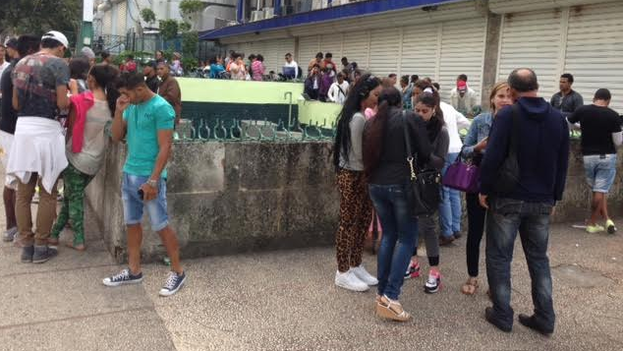
![]() 14ymedio, Zunilda Mata, Havana, 25 January 2016 – From their respective corners of the bench they point their phones at each other as if they were in the midst of a duel to the death. After a few seconds one of the young men shouts, “I got it!” and both smile at the effective transmission of a file with the Zapya app, an increasingly handy application for exchanging files in Cuba.
14ymedio, Zunilda Mata, Havana, 25 January 2016 – From their respective corners of the bench they point their phones at each other as if they were in the midst of a duel to the death. After a few seconds one of the young men shouts, “I got it!” and both smile at the effective transmission of a file with the Zapya app, an increasingly handy application for exchanging files in Cuba.
Zapya is the tool of the hour on Havana’s streets, especially among children and teens. Its users use it to exchange – easily and quickly – photos, videoclips or applications to install on their smart phones. Its creators have described it as a utility that allows transfer rates “hundreds of times faster than you get using Bluetooth.”
With a simple and intuitive interface, Zapya is available in Android and iOS versions. Its programmers boast of having exceeded 300 million users worldwide, thanks to a Chinese version that is gaining popularity among users in the Asiatic giant.
Its intuitive design makes Zapya an easy-to-use tool, with files received at an approximate speed of 10 MB per second.
For Epiphany, the traditional Christmas gift-giving day in Cuba, many children asked for “a tablet with Zapya,” which led other Cuban parents to have to deal with installing the application on their own devices. The tool has many followers in elementary schools, where the children amuse themselves exchanging songs and videos and where many teachers have started a full-out battle against the application.
“At my daughter’s school bringing phones is banned, because they spend the whole day playing games and sending little messages,” comments the mother of a nine-year-old in Havana’s Plaza district. When her daughter heads to class she goes to the park to “zapya,” explains the mother, using the word as a verb, which is spreading in popular speech.
The most attractive part of the application is the chat function, which allows the exchange of messages free, and without needing access to the internet. “This is driving the teachers crazy, because the students use it to mock the teachers, fall in love, and even send each other the answers to the tests,” says Mirtha, the mother of a teenager in high school.
In Wifi zones the use of Zapya is also proliferating. “I come, I start to download what interests me, and I’m going to send it to several friends,” says Ivan, 19, who was connected in Havana’s La Rampa area this weekend to download “videogame tricks.”
Zapya has gained ground thanks to its distribution in the so-called “weekly packet” that circulates throughout the country. Along with anti-virus updates, and other applications for smartphones, the tool has managed to reach a wide audience that uses it as a substitute for WhatsApp, because you don’t have to be connected to the web to use it.
At the end of 2015, State telecommunications industry authorities claimed that 150,000 Cubans connect to the Internet in public wifi areas every day, but the island is still among the countries with the lowest rates of connectivity in the world; only 5% of population is on-line (and only slightly over 1% are using broadband).
Among the many ways to overcome these obstacles, Zapya is today one of the most creative and popular applications. Ease of use, privacy and its ability to operate offline are keys to its success among Cubans.
